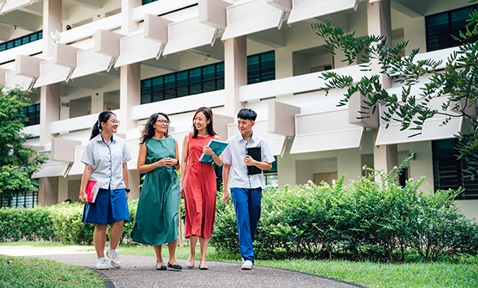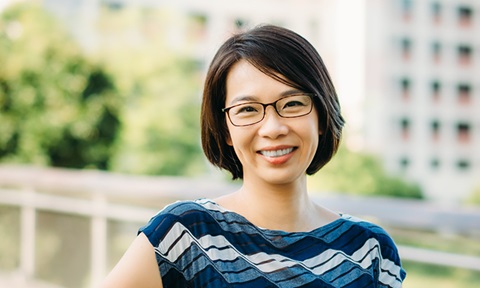GEP 'not only about academics': Current, former students highlight small class sizes, special resources
SINGAPORE: When Jewel Kwek transferred to Raffles Girls’ Primary School last year after making the cut for the Gifted Education Programme (GEP), she was nervous about adapting to a new environment.
But her anxiety soon faded as she found herself enjoying the "intellectual sparring" with her classmates and the more challenging curriculum.
For example, mathematics classes went beyond solving maths problems to understanding how a formula is applied to a problem.
“That gives us a deeper understanding of maths,” said the 10-year-old, who is now in Primary 5. “It also gives me more appreciation of the people who invented the formulas.”
Her classmate, 11-year-old Averie Loh, also said she felt more engaged. With a smaller class of 23 students, she could speak up more often. The resources available to GEP students, like access to Google Classroom, have been useful too.
Both Jewel and Averie said they were disappointed to learn that the GEP would be revamped and that future students could have a different experience.
At his first National Day Rally speech on Sunday (Aug 18), Prime Minister Lawrence Wong announced that the GEP would be “discontinued in its current form”, with high-ability programmes in all schools to be opened up to more students.
Other changes include no longer requiring students to be transferred to specific schools that offer the GEP. Students can also join or leave these programmes at multiple points between Primary 4 and 6, instead of being selected in Primary 3 like they are now.
Two former GEP students and two parents with children who attended the GEP also told CNA that the gifted programme stood out for its curriculum – with interdisciplinary content and emphasis on creative and critical thinking in smaller class sizes.
They were supportive of the policy changes to allow more students to access the programme, but had questions on how that could be implemented while maintaining the pedagogy of the GEP.
What are the changes to Singapore's Gifted Education Programme?
Introduced in 1984, the GEP takes in 1 per cent of the cohort each year and transfers those selected to nine primary schools.
The schools are Raffles Girls’ Primary School, Rosyth School, Anglo-Chinese School (Primary), Nanyang Primary School, Tao Nan School, Henry Park Primary School, Catholic High School (Primary), St Hilda’s Primary School and Nan Hua Primary School.
Starting with the 2024 Primary 1 cohort, selected students do not have to transfer to these schools to join the GEP. Instead, they can opt for high-ability learning programmes at their own primary schools.
These programmes – which have been progressively developed in primary schools since 2007 – will be expanded to take in 10 per cent of all primary school students, up from 7 per cent now, while considering a wider range of abilities than the current GEP.
Students who benefit from further development can choose to attend after-school modules at designated nearby schools.
QUESTIONS ON TEACHING RESOURCES
Mr Adrian Chia, an ex-GEP student who went to Raffles Institution, said he benefited from being in a small class of 22 students and wondered if this would be possible with the new GEP taking in more students.
"The last thing I want is teachers to have to shoulder more load in order to achieve the desired effect," said the 45-year-old, who was in the Navy until he retired three years ago.
Another question raised by those who spoke to CNA was the availability of trained teachers to administer the expanded high-ability learning programmes.
GEP teachers play a critical role in guiding and enabling a stimulating learning environment, as well as knowing how to handle the “uniqueness” of a gifted child, parents with GEP children said.
“It’s not just about kids being gifted, but the ability to think out of the box comes when they are asked different questions and exposed to other types of views,” said Mrs Mabel Tan.
“This really comes down to the teachers who come up with different ways to engage the kids. Schools can send teachers for training but it will also require teachers to break out from mainstream teaching.”
The Ministry of Education's (MOE) Gifted Education Branch currently organises the enrichment programmes and activities for high-ability learners.
Execution of these programmes will depend on whether teachers have experience guiding such learners, said Dr Jason Tan, associate professor at the National Institute of Education (NIE).
For teachers without experience, “there will definitely be a lot of learning”, he said.
With more students in the high-ability programmes, teachers may also have to meet more diverse learning needs in their classrooms, Dr Tan added.
But educators said schools are already equipped to handle these students' needs.
Mrs Zahira Mohamed Sedik, a former GEP teacher and now the vice-principal of Tampines Primary, said the school's teachers are trained in high-ability learning programmes.
Asked if teachers may face a higher workload, Mrs Zahira said guidelines to factor in their well-being are in place. For example, the additional training needed to teach high-ability students is considered part of their workload.
Mrs Ushanthini Arumugam, a GEP teacher at St Hilda's Primary, said differentiated learning is already being applied outside of GEP classes in the school.
St Hilda's is one of the nine GEP schools. In recent years, GEP students have been placed in what the school calls "mixed-form classes", where they attend non-academic subjects such as physical education and music with mainstream classmates.
The school has also adapted and refined programmes and pedagogical practices piloted in GEP classrooms for other students.
When the revamped GEP is introduced, Mrs Ushanthini expects she will need slightly more time to create differentiated learning plans for students.
"When GEP students go beyond and are interested to find out more about a topic or concept, I will tailor and design my lessons based on their needs to sustain their interest and curiosity.
"Instead of frontal teaching, the teacher takes on the role of a facilitator in the class to move discussions and probe them further," said Mrs Ushanthini, adding that students are given the opportunity to lead discussions.
"These students usually benefit a lot from open-ended tasks of inquiry and time is given to them to engage in critical and creative thinking, which enriches their learning experiences."
QUESTIONS ON SELECTION CRITERIA, AFTER-SCHOOL MODULES
Parents also had questions about the qualifying criteria. Currently, Primary 3 students can choose to sit for a set of two standardised GEP tests. Under the new system, students only need to take the first test, which examines their English and mathematics capabilities.
Schools can also identify suitable students – at multiple junctures between Primary 4 and 6 – based on day-to-day observations, teacher recommendations and their work. These screening methods have “no set weighting”, MOE said.
Mrs Tan, whose child has graduated from the GEP, said the changes depend heavily on the teachers’ understanding of their students.
“With the tests, it’s very clear cut … But what happens if a class goes through many teachers because of reasons like maternity leave? How will it be fair for the child when they are being judged by a new teacher? Does it give room for some parents to argue against a teacher’s decision?”
Some “identifiable qualities” might be necessary for teachers to make their observations and recommendations, Mrs Tan added.
Questions were also asked about the after-school modules.
While a cluster approach makes sense in rationalising teaching resources, these modules may clash with co-curricular activities or other after-school programmes that students have, parents and former GEP students said.
Having to travel to another school might also be a burden for some less well-to-do families, they said.
GEP WAS MORE THAN JUST STUDIES: EX-STUDENT
Dr Johannis Auri Abdul Aziz, a former GEP student, said the gifted programme was “not only about academics”.
Citing a MOE handbook that said the GEP also catered to “the social and emotional needs” of its students, he said: “In a sense, it’s not just a gifted programme. It’s also a special needs programme.”
A 2005 study of former GEP students found that some have trouble coping and are ostracised by their non-GEP classmates.
Recalling his days in GEP as being “both good and bad, socially speaking”, Dr Johannis said: “Kids can be cruel. There was a fair share of admiration, as well as resentment and some amount of rejection.
“This is why having friends with a common experience can be valuable and people who are more accepting of you,” said the 44-year-old, adding that he made many lifelong friends from his days in GEP.
Dr Johannis said he would like to hear more about MOE’s plans to ensure the programme continues to meet the emotional and social needs of high-ability students.
A BROADER EDUCATION REFORM
The GEP, which is in its 40th year, is not without its critics. Over the years, concerns have been raised about “hothousing” – educating children to a high level at an earlier age than is usual – and how it breeds elitism.
Dr Johannis admitted that the “isolation” of GEP students during his time led to “some in-culture breeding”.
“On one hand, it builds an identity, but it also alienates you from the rest and I think that’s a negative point,” he said.
But MOE has taken steps over the years to address that, he acknowledged, adding that the latest changes could help address the issue of segregating children from a young age.
Mr Ian Siah, whose two children attended the GEP, welcomed the move to allow students to stay in their own primary schools.
He recalled how his older son felt torn about leaving his friends at his former primary school and later went through an adjustment process when he transferred to Anglo-Chinese School.
Some of his son’s classmates opted to drop out of GEP as they did not want to change schools. Transferring to a new school could also mean logistical challenges.
Experts like NIE's Dr Tan said the changes are in line with the broader overhaul of Singapore’s education system to recognise diverse talents and provide more customisation for students with different learning needs.
The changes to the selection criteria, in particular, take into account that students mature at different stages of their lives and send a “strong message” about second chances, said Mr Jonathan Sim, a philosophy lecturer at the National University of Singapore (NUS).
“The stress of our education system has always been that people feel that there is no second chances – you either make it or that’s it. This creates a lot of unnecessary pressure,” said Mr Sim who is also fellow at the NUS Teaching Academy.
“This (gives) our learners the psychological safety they need to experiment, explore and grow well.”
Read the original article here.
Source: Channel NewsAsia © Mediacorp Pte Ltd. All rights reserved.




.tmb-listing.jpg?Culture=en&sfvrsn=1a71f9dd_1)
.tmb-listing.jpg?Culture=en&sfvrsn=59cb7fe4_1)

.tmb-listing.jpg?Culture=en&sfvrsn=6458dd7a_1)